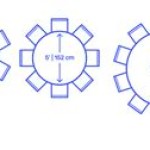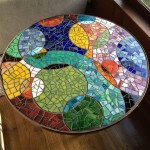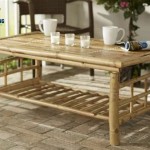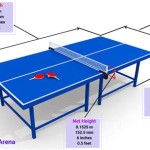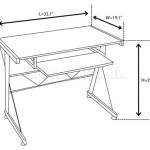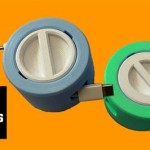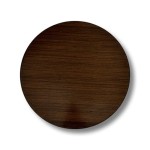Rustic Wood Dining Table With Metal Legs: A Synthesis of Style and Durability
The rustic wood dining table with metal legs represents a significant trend in contemporary furniture design, bridging the gap between traditional warmth and industrial chic. These tables are characterized by their robust construction, utilizing natural wood elements contrasted with the clean, often minimalist lines of metal supports. The combination offers a compelling aesthetic that complements a variety of interior design styles, from farmhouse and industrial to modern and eclectic.
The appeal of this type of dining table lies in its ability to evoke a sense of authenticity and durability. The imperfections inherent in natural wood, such as knots, grain variations, and minor cracks, are celebrated rather than concealed. These features tell a story, suggesting a connection to nature and a departure from mass-produced uniformity. The addition of metal legs provides a grounding element, offering structural stability while contributing to the overall visual impact.
Material Selection: The Core of Aesthetic and Function
The choice of materials is paramount in the creation of a high-quality rustic wood dining table with metal legs. The type of wood used for the tabletop significantly impacts the table's appearance, durability, and longevity. Popular wood choices include reclaimed wood, solid hardwood (such as oak, maple, and walnut), and engineered wood products with wood veneer. Each material offers distinct advantages and disadvantages.
Reclaimed wood, sourced from old barns, factories, and other structures, provides a unique character and inherent sustainability. It often exhibits a weathered patina and distinctive markings that cannot be replicated in newly harvested wood. However, reclaimed wood can be more expensive and may require specialized treatments to ensure stability and prevent pest infestations.
Solid hardwood options offer exceptional durability and a classic aesthetic. Oak is known for its strength and prominent grain, while maple provides a smoother, more refined surface. Walnut is prized for its rich color and luxurious feel. Solid hardwood tables are typically more expensive than those made from engineered wood, but they can last for generations with proper care.
Engineered wood products, such as plywood and MDF (medium-density fiberboard), are often used as a core material for tabletops, with a wood veneer applied to the surface. This construction method offers several benefits, including increased stability, resistance to warping and cracking, and a more affordable price point. The quality of the veneer and the craftsmanship of the table are crucial to ensuring a durable and aesthetically pleasing final product.
For the metal legs, steel and iron are the most common materials. Steel offers a good balance of strength, affordability, and workability. It can be finished in a variety of ways, including powder coating, painting, and clear coating, to achieve different aesthetic effects and protect against corrosion. Iron is a heavier and more robust material, often used for legs with a more industrial or rustic appearance. It typically requires a protective coating to prevent rusting.
Design Considerations: Balancing Form and Function
The design of a rustic wood dining table with metal legs involves careful consideration of both form and function. The table's dimensions must be appropriate for the intended seating capacity and the size of the dining space. The shape of the tabletop, whether rectangular, square, round, or oval, influences the table's visual presence and its ability to accommodate different seating arrangements.
The design of the metal legs plays a crucial role in the table's stability and overall aesthetic. Simple, straight legs offer a minimalist and contemporary look, while more elaborate designs, such as trestle legs or hairpin legs, can add a touch of vintage charm or industrial flair. The thickness and placement of the legs also affect the table's perceived weight and visual balance.
The finish of the wood tabletop is another important design element. Options range from natural finishes that highlight the wood's inherent grain and color to stained finishes that alter the wood's appearance. A clear coat of sealant is typically applied to protect the wood from moisture, stains, and scratches. The level of gloss can also be adjusted to create a matte, satin, or glossy finish.
The metal legs can be finished in a variety of colors and textures to complement the wood tabletop. Black is a popular choice for its versatility and ability to create a striking contrast with the wood. Other options include brushed steel, powder-coated colors, and finishes that mimic the look of aged metal.
Durability and Maintenance: Ensuring Longevity
The durability of a rustic wood dining table with metal legs depends on the quality of the materials and the construction techniques used. Solid hardwood tables are generally the most durable, while engineered wood tables with high-quality veneers offer a good balance of durability and affordability. The metal legs should be securely attached to the tabletop to ensure stability and prevent wobbling.
Proper maintenance is essential to prolong the life of the table and maintain its appearance. Regular cleaning with a damp cloth is sufficient for most surfaces. Avoid using harsh chemicals or abrasive cleaners, as they can damage the wood finish and the metal coating. Spills should be cleaned up promptly to prevent staining.
For wood tabletops, periodic application of furniture polish or wood conditioner can help to protect the wood from drying out and cracking. Scratches and minor imperfections can often be repaired with wood touch-up markers or wax sticks. Metal legs can be cleaned with a damp cloth and mild soap. Rust can be removed with a wire brush and a rust-inhibiting primer applied to prevent further corrosion.
The environment in which the table is placed can also affect its durability. Excessive humidity or dryness can cause wood to warp or crack. Avoid placing the table in direct sunlight, as this can fade the wood finish. Consider using placemats and coasters to protect the tabletop from heat and spills.
The choice of seating around the table can also contribute to its longevity. Opting for chairs with felt pads on the feet can help to prevent scratches and dents on the floor. Using a tablecloth or runner can further protect the tabletop from damage during meals.
In summary, the rustic wood dining table with metal legs presents a harmonious blend of natural materials and industrial design. Its enduring appeal stems from its inherent character, durability, and adaptability to diverse interior styles. By carefully considering the materials, design, and maintenance requirements, individuals can select a table that not only enhances their dining space but also stands the test of time.

Rustic Dining Table Bench Set Square Steel Legs Industrial Style Scaffold Board Solid Wood Reclaimed Kitchen Farmhouse Singapore

Industrial Farmhouse Table With Benches Rustic Steel Legs Provincial Brown Wooden Top 6ft Dining Set Industrail Design Singapore

Industrial Farmhouse Table With Benches Rustic Steel Legs Provincial Brown Wooden Top 6ft Dining Set Industrail Design Singapore

Solid Wood Dining Table Rustic Farmhouse Reclaimed With Steel Base Singapore

Industrial Reclaimed Solid Wood Dining Table And Bench Set With Chunky Steel Legs Rustic Handmade Singapore

Industrial Dining Table And Benches Reclaimed Rustic Wood Timber Farmhouse Steel Legs Scaffold Boards Singapore

Industrial Steel Reclaimed Wood Dining Table And Bench Set Rustic Kitchen Singapore

Live Edge Dining Table V Frame Legs Industrial Rustic Wood Singapore

Extending Dining Table With Steel Legs Modern Industrial Style Box Hairpin Extendable Singapore

Industrial Reclaimed Solid Wood Dining Table And Bench Set With Chunky Steel Legs Rustic Handmade Singapore

